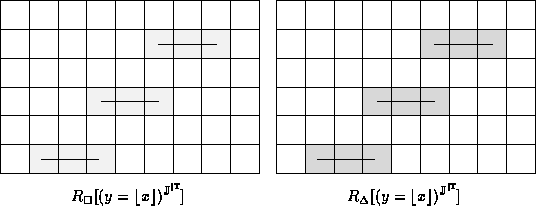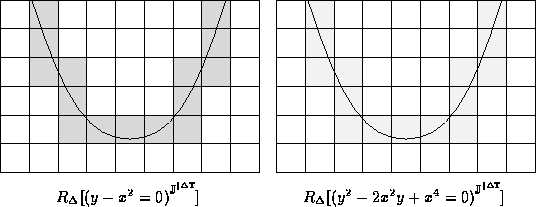




Next: 4.2.7 Linear Interval Arithmetic
Up: 4.2 Basic Rendering
Previous: 4.2.5 Exhaustive Subpixel Testing
Subpixel sample testing rarely verifies one-dimensional
elements of graphs.
Consider a graph G[g = 0], with  .
Consider
.
Consider  ,
,
 .
If
.
If
then we set  to
to  ,
since
so
The corners of
,
since
so
The corners of  are common initial choices
for
are common initial choices
for  and
and  .
Continuity-based testing is often used in place of
subpixel sample testing where = occurs in a specification.
.
Continuity-based testing is often used in place of
subpixel sample testing where = occurs in a specification.
Compare the following two  renderings
of
renderings
of  , produced using, and not using, continuity-based testing:
, produced using, and not using, continuity-based testing:
 denotes a rendering produced using
continuity-based testing.
With sample testing, a sample must be chosen which lies
within a graph; with continuity-based testing, a pair
of samples must be chosen such that the graph lies between
the two samples.
If each sample is a point within
denotes a rendering produced using
continuity-based testing.
With sample testing, a sample must be chosen which lies
within a graph; with continuity-based testing, a pair
of samples must be chosen such that the graph lies between
the two samples.
If each sample is a point within  ,
and the samples are chosen
uniformly and independently, the outer pixels of each step have a 25% chance
of being verified as
,
and the samples are chosen
uniformly and independently, the outer pixels of each step have a 25% chance
of being verified as  , while the inner pixel of each step has a 50% chance
of being verified as
, while the inner pixel of each step has a 50% chance
of being verified as  .
With subpixel sample testing, each pixel has a 0% chance of being
verified as
.
With subpixel sample testing, each pixel has a 0% chance of being
verified as  .
.
Consider the following two renderings, both
of which employ continuity-based testing:
Continuity-based testing fares poorly with  ,
as
,
as  is non-negative for all (x,y).
is non-negative for all (x,y).





Next: 4.2.7 Linear Interval Arithmetic
Up: 4.2 Basic Rendering
Previous: 4.2.5 Exhaustive Subpixel Testing
![]() .
Consider
.
Consider ![]() ,
,
![]() .
If
.
If
![]()
![]()
![]()
![]() renderings
of
renderings
of ![]() , produced using, and not using, continuity-based testing:
, produced using, and not using, continuity-based testing:

